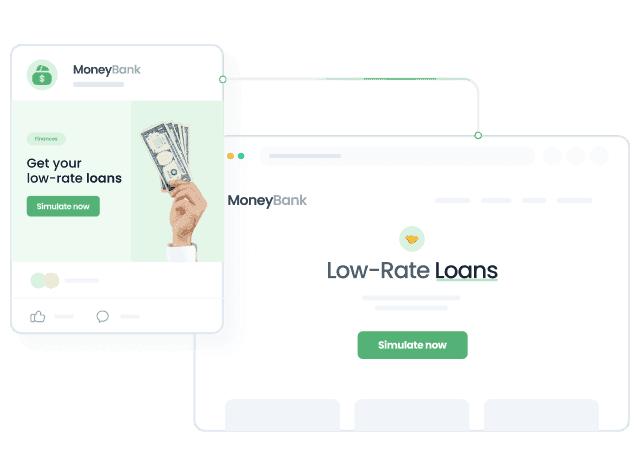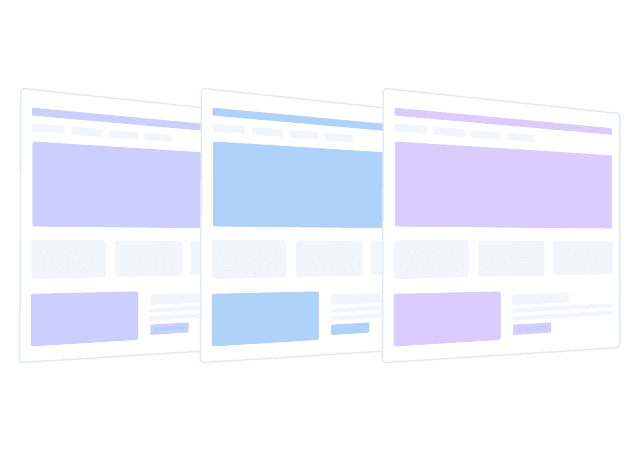Drive conversions: 7 tips for landing page optimization
Have you ever clicked through an attractive ad hoping to land on a page with more information but then abandoned it because it failed to hold your attention?
To avoid this kind of experience, it is crucial to follow the best practices when creating landing pages that drive conversions.
A landing page is where prospects arrive from anywhere on the internet — an ad, a newsletter, or a Google search result. Its main goal is turning visitors into leads.
Read this post to learn how to drive conversions by using 7 vital landing page best practices.
Learn step-by-step how to dynamically change images and copies based on the ads that brought users to your site.

How to drive conversions on your landing page
Your landing page should capture your visitor's attention and encourage them to convert. So if yours fails to convert well, there's a chance you're missing some critical strategies that trigger conversions. The following best practices should give you a head start in creating an effective and highly converting landing page.
1. Have a clear design and remove distractions
A landing page should have one primary purpose — encouraging users to download a free ebook, signup for a free trial, subscribe to a limited offer, and so on. A design with more than one focus defeats the purpose of a landing page.
Landing pages exist to drive conversions, so try to eliminate any element that diverts attention from conversion and ends up confusing users. You should limit the distractions on your page and include only what you need to convince users to convert.
Also, crowding your page with many offers confuses users. If you're selling two products, build separate landing pages for them. That means product A should have landing page A, and product B should have landing page B.
Remove distractions by using the same copy style throughout the page. Your design colors should be complimentary, not clashing. The font sizes should follow an expected scale. Weigh each word and image to ensure they drive visitors to conversion.
2. Use authentic social proof
Social proof is one of the effective ways to boost conversions on your landing page. It validates your offer without you even saying anything. Showing users that other customers willingly rave about your product builds trust and credibility for your brand.
Some social proof ideas include product reviews, client testimonials, logos of brands you've worked with, and product purchase confirmation. You can even humanize client testimonials by including personal details like full names, job titles, portraits, and date of purchase.
3. Show your product or service in action
Effectively showing your product in action demonstrates how it works and its benefits to your users. A video, for instance, is an excellent way to explain complex concepts quickly.
Having a 30-second clip of quality, informative product video on your landing page can capture and keep your visitors' attention, leading them to convert.
Use animations, demo videos, or still pictures to explain how your product or service works. For videos, keep it short, not more than 90 seconds. Remember that landing pages should hold attention, so do not bore your visitors with long videos.
4. Use clear, compelling copy
The words on your landing page should speak directly to the visitor and convey your brand's message clearly and compellingly. Including bold headings, bullet points, and short sentences makes your copy easy to read. Users typically scan content instead of reading each line, so keep it clear and concise.
When writing copy for your landing page, use "power" words. Power words grab your attention, get to your emotions, and compel you to take action. It's a time-tested copywriting tactic that is sure to drive conversions.
Your copy should also make customers feel like you've read their minds, meaning it should have language/market fit. Find the exact words users use to explain the jobs they’re trying to get done. Using words that speak to the goals and challenges in their heads turns your visitors into customers.
5. Keep your form fields simplified
Just as nobody likes paperwork, nobody wants to fill out lengthy forms. When faced with an extensive form field, it's natural that visitors begin to ask themselves: "Why do they need to know all this?" The more fields a visitor is requested to fill out at once, the lower your conversions.
If you need more information from your prospects, use the progressive profiling technique. It's a non-intrusive way of breaking down a massive form field by spreading the questions over time.
You should ask only for what you really need in the first moment on your lead generation form — maybe just the user's name and email. After that, you can gradually get more information by using personalization to display dynamic forms. We'll talk about personalization in the next section of this post.
6. Personalize your landing page
If you want your landing page to drive visitors to take action, it must connect and speak to them. One way to do this is by using dynamic content to personalize it. Personalization is a powerful way to increase conversions with your target audience and generate quality leads for your company.
A personalized landing page outperforms a static landing page because it builds upon customer data such as past behavior, time, location, and so on.
This is how it works — let's suppose you're advertising the same product or service to different audiences. While the product or service is solving different problems for each persona, each targeted audience should receive a different message.
With dynamic content, you can provide different versions of the same landing page in a single URL. That provides your prospects with content related to what they're looking for, and ultimately drives conversions.
Learn the secret to having many landing pages in one single URL and scale.

7. AB test different page elements
After creating different versions of your landing page, we recommend you test them to check which one performs better. Running AB tests with personalization is one of the most effective ways of optimizing your landing pages for conversions.
The role of AB tests is to determine what works and what doesn't. On a landing page, elements as small as the color of your CTA button can make a difference in your conversions. But without testing it, you can never know which color made that difference.
Constantly testing different elements of your page improves its performance and boosts your conversion rate. You should try combinations of your headline, copy, CTA, images, buttons, and other design elements. Test one element at a time, not everything at once. Make minor changes and see how they affect user behavior.
Create a landing page that converts
The main entry point for potential clients to access your product or service is through landing pages. It accounts for most of your new leads, so you should create it to increase performance and drive more leads.
Following the best practices from this post will set you on your way to create a high-converting landing page.
If you're struggling to make your landing pages convert, or you don't know where to start, create your free account and explore our platform.